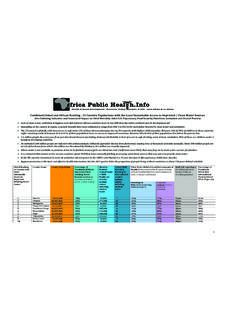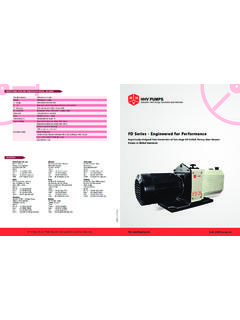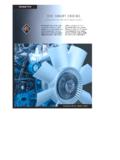Transcription of Improved Chilled Water Piping Distribution …
1 Improved Chilled Water Piping Distribution methodology for Data Centers White Paper #131 By Isabel Rochow 2006 American Power Conversion. All rights reserved. No part of this publication may be used, reproduced, photocopied, transmitted, or stored in any retrieval system of any nature, without the written permission of the copyright owner. Rev 2006-0 2 Executive Summary Chilled Water remains a popular cooling medium; however leaks in the Piping systems are a threat to system availability. High density computing creates the need to bring Chilled Water closer than ever before to the IT equipment, prompting the need for new high reliability Piping methods.
2 This paper discusses new Piping approaches which can dramatically reduce the risk of leakage and facilitate high density deployment. Alternative Piping approaches and the advantages over traditional Piping systems are described. 2006 American Power Conversion. All rights reserved. No part of this publication may be used, reproduced, photocopied, transmitted, or stored in any retrieval system of any nature, without the written permission of the copyright owner. Rev 2006-0 3 Introduction In data centers, the traditional approach to Piping Distribution has been to use hard copper or carbon steel Piping with welded, brazed or threaded fittings for routing and branching of the Piping to the air conditioners.
3 Since every fitting used in the Piping line increases the leak failure potential in the data center, Piping Distribution is generally located under the raised floor where channels or trenches are sometimes built under the pipe to capture Water in case of any leaks or rupture. This approach worked in static data centers, where there was no need to relocate or add air conditioners. With the current trend of increased densities in IT equipment and more frequent moves, additions, and changes, air conditioners must occasionally be added to the traditional lay-out where the use of hard Piping becomes problematic. These additions require new Piping to be installed, increasing deployment time of the equipment and increasing the risk of down time associated with the installation.
4 The result is that there is a need in the industry for a more flexible modular system of Piping that can better accommodate changing requirements. A new trend is data centers that do not use a raised floor. These hard-floor installations are enabled by newer cooling technologies and architectures that do not require a raised floor for air Distribution . For many users this allows additional flexibility of placement of data centers and computer rooms. One result of this trend is that overhead Piping has become more common. Leaks in overhead Piping can be even a greater risk to system downtime and damage than underfloor Piping . There is a need in the industry for a more leak-resistant Piping system.
5 A further trend in data center design is the deployment of cooling at the IT equipment row locations (In-row), or even to individual racks, rather than at the room level. This is done to allow higher density and greater electrical efficiency, and is discusses more completely in APC White Paper #130, The Advantages of Row and Rack-Oriented Cooling Architectures for Data Center . This type of deployment forces the air conditioning units and the associated Piping closer to the IT equipment. Again this situation requires a more reliable, modular, and scalable Piping system. The use of seamless flexible Piping eliminates the use of intermediate fittings, mitigating the risk of Water leaks, reducing deployment time, and increasing the agility of the system.
6 This paper explains this new Piping technology and its application to next-generation data centers. Characteristics of traditional hard Piping methods The use of hard copper or carbon steel Piping is the traditional approach in data centers. Carbon steel pipe schedule 40 and hard copper pipe type L or M are most commonly used. Hard Piping requires the use of threaded, grooved, welded or brazed fittings at every turn, at every valve, at every branch to multiple air 2006 American Power Conversion. All rights reserved. No part of this publication may be used, reproduced, photocopied, transmitted, or stored in any retrieval system of any nature, without the written permission of the copyright owner.
7 Rev 2006-0 4conditioners and at every or 6 meters (6 or 20 feet), depending on the available length of the pipe run. It is common to have multiple fittings in one pipe run from the Chilled Water source to the air conditioner. Failure modes of hard Piping Each threaded or welded fitting presents a leak potential for the Chilled Water system. One common reason for leakage is the threading process which removes 50% or more of the pipe wall beginning on day one and weakens that joint. Another reason for pipe failure and Water leakage is galvanic corrosion, where the carbon steel pipe directly meets a brass valve, or is transitioned to copper pipe. "Galvanic" corrosion occurs between any two dissimilar metals in contact with each other and Water , and typically attacks the steel pipe to a degree somewhat dependent upon existing corrosion conditions.
8 It is visually recognizable in its latter stages by some degree of deposit buildup where the dissimilar metals meet at the threads, creating a micro-fine leak. At that point, however, most of the damage has already occurred and replacement of that pipe is required, otherwise the leak size would increase as corrosion advances. Electrically isolating fittings, called dielectrics, are used for connections between dissimilar metals in most Piping systems. Dialectric fittings are specified by most consulting and design engineers, but it is not uncommon to find installations where they were not installed or they are installed incorrectly. In a traditional Chilled Water installation, it is not uncommon to see a main carbon steel supply or return pipe that branches to the air conditioners with copper Piping , so multiple dielectric fittings might be used if several computer room air conditioners (CRAC) are in the data center.
9 Other less common reasons include the failure of the thread sealant over time, poor machining of the threads, gasket deterioration in grooved connections and poor quality of the pipe or fittings, vibration, stress, improper assembly, or excessive operating pressures beyond design. In hard Piping systems, minerals tend to build up on the interior wall causing scaling and oxidation of the copper and eventually creating pinholes and leakage in the Piping . Mineral build-up overtime also increases the pressure drop in the Water line, especially when it is deposited in elbows or fittings. To avoid this problem, Water has to be treated and maintained periodically to ensure proper PH levels. The Water is usually treated at the time of start-up and during regular services.
10 Even though it is rare to see pinholes in a closed loop Chilled Water installation, it has been found in installations were poor maintenance was performed. Condensation also presents a problem in a Chilled Water system. Chilled Water Piping is usually insulated to prevent condensation in the Piping exterior. However, it is not uncommon to find moisture on the Piping fittings where multiple elbows, connections, and fixtures such as valves, strainers, and gauges make an effective insulation job difficult. Any crack or sealing failure in the insulation presents Water potential in the 2006 American Power Conversion. All rights reserved. No part of this publication may be used, reproduced, photocopied, transmitted, or stored in any retrieval system of any nature, without the written permission of the copyright owner.












